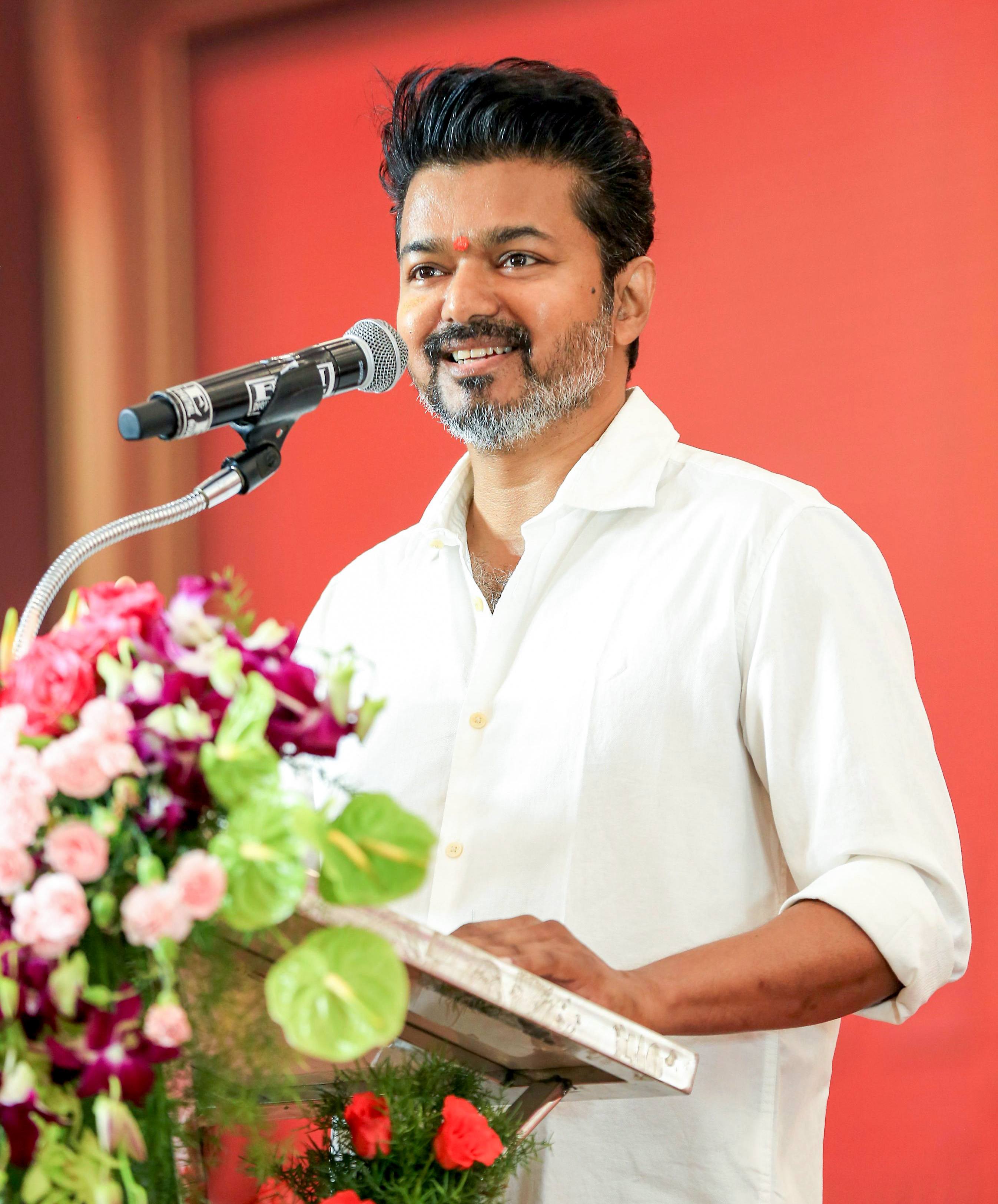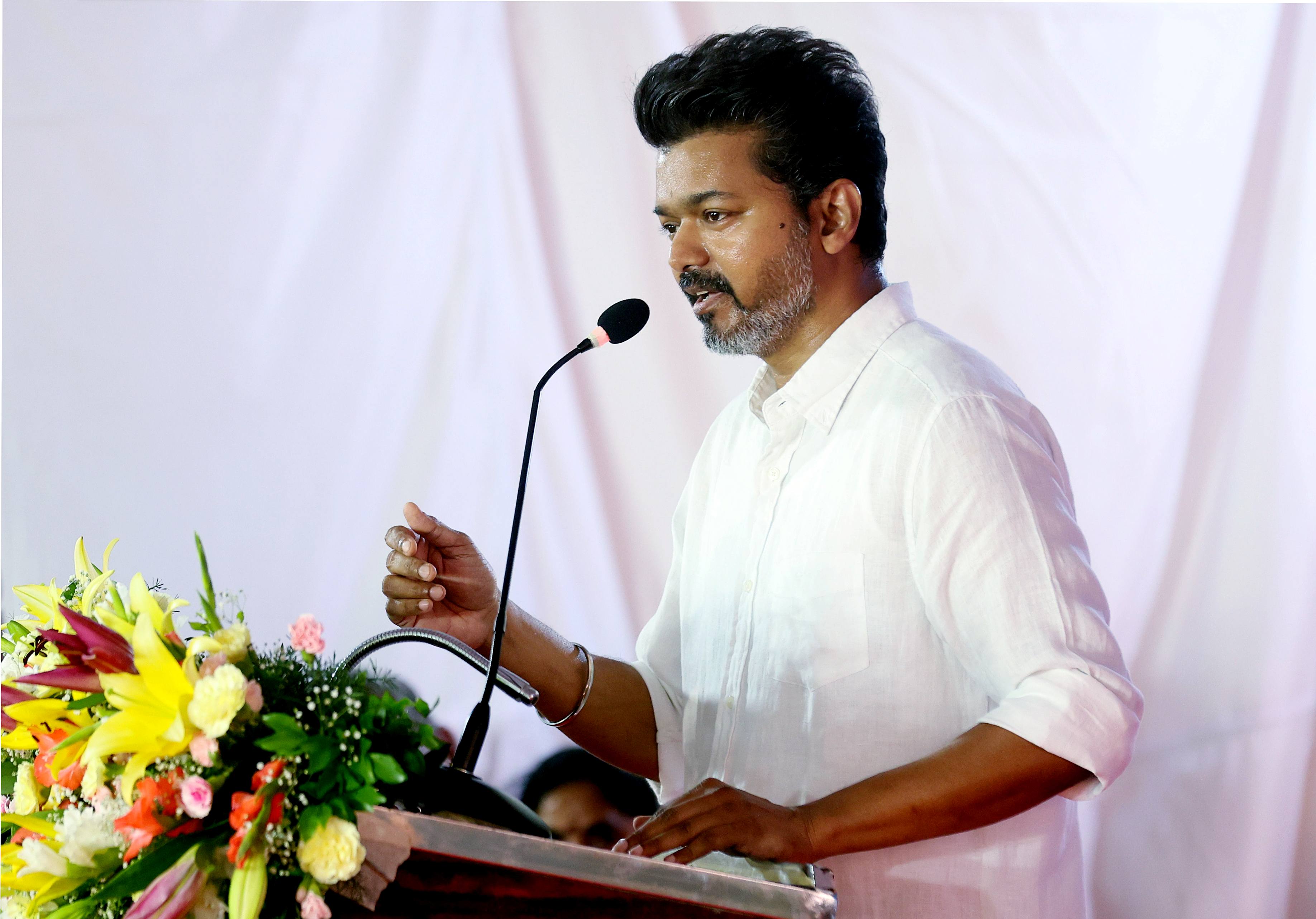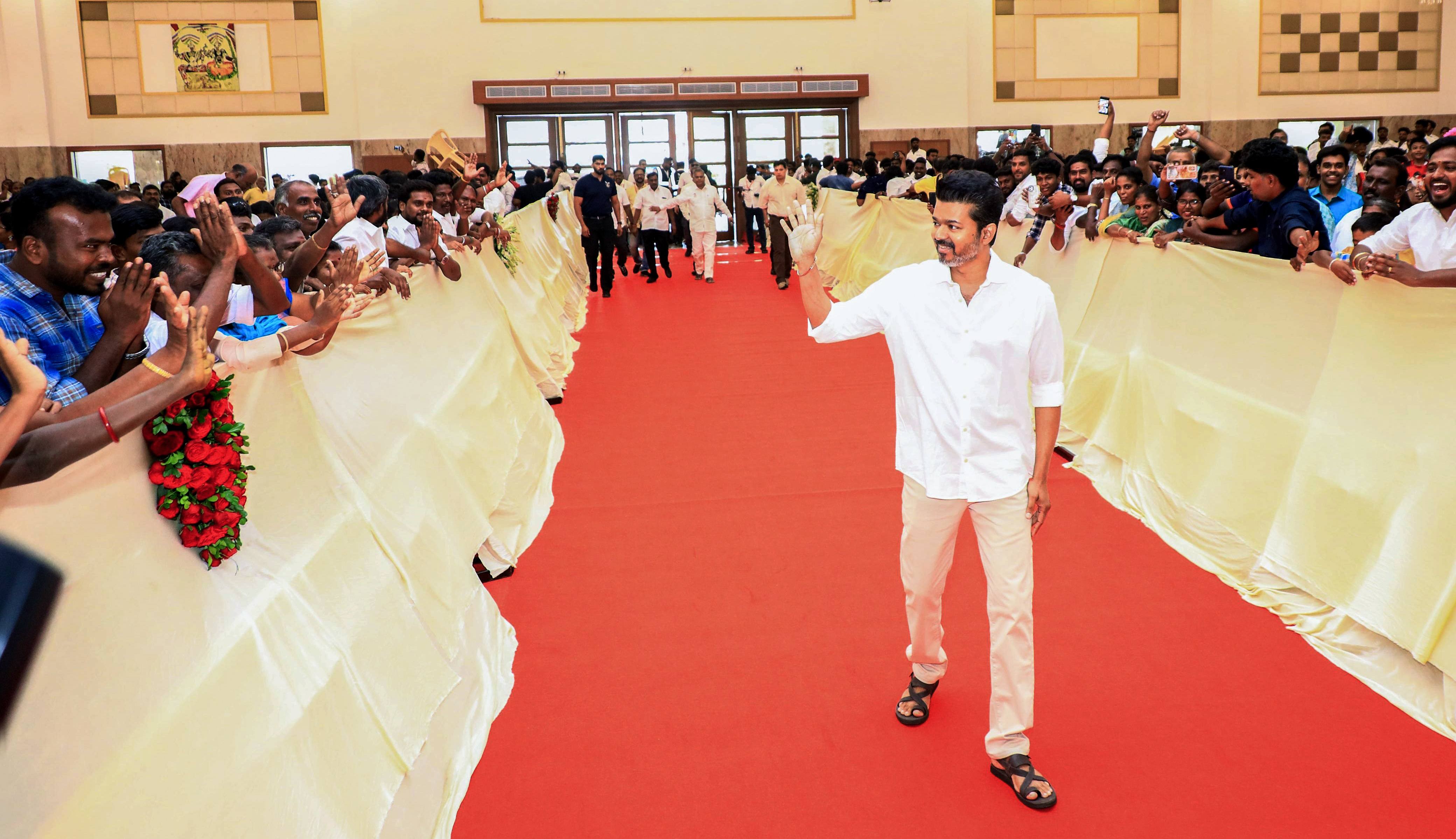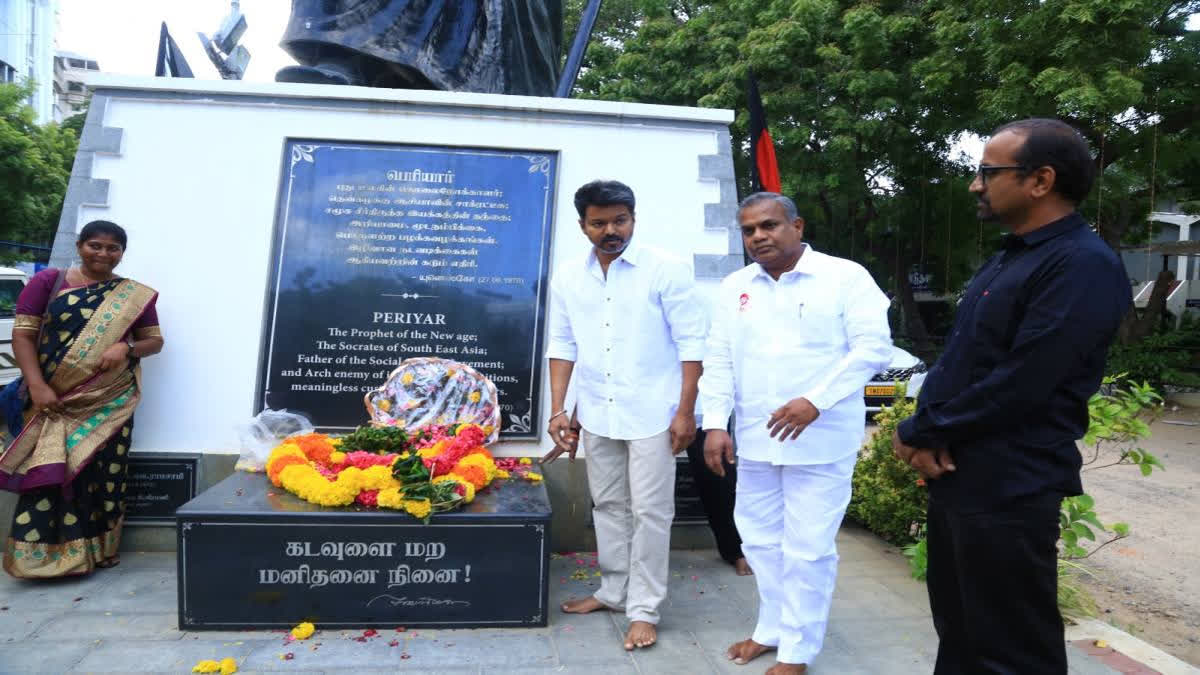Actor Vijay has announced the Tamizhaga Vetri Kazhagam (TVK) will hold its first state conference will be held on October 27 in Villurpuram district.
Vijay's garlanding the statue of E V Ramasamy (widely known as Periyar) in Periyar Thidal has propped up the debate over his political constituency, which he is expected to set out in the maiden party conference of his recently recognised political party.
Not just Periyar, the actor has greeted Prime Minister Narendra Modi on his birthday and also extended his greetings on the birth anniversary of former Tamil Nadu Chief Minister CN Annadurai. Last month, the actor unveiled his party flag and the anthem, which was meant to be a prelude to his actual political plunge.
On February 2, the top Tamil actor announced the launch of his political party. He drew his conviction to enter politics from the current situation which he said was "fraught with administrative deterioration, corruption and divisive politics that impedes unity".

The 50-year-old asserted that the people of the state were yearning for a change. "People of Tamil Nadu are yearning for a political movement that would pave the way for a selfless, transparent, visionary and efficient administration that is free of corruption, and caste and religious differences," he said.
When his party contests in the Legislative Assembly Elections in 2026 is likely to be the first major player with 'Tamil nationalism' at its core, if one were to go by what the symbols in the flag, anthem and name show. The actor has announced that there was a deep meaning to the party flag which he would reveal in the party conference.
There are no elements of 'Dravida' as was seen in the arch-rivals - the MK Stalin-led Dravida Munnetra Kazhagam(DMK) and the Edappadi K Palaniswami-led All India Anna Dravida Munnetra Kazhagam (AIADMK). The term Dravida was introduced in Tamil Nadu’s political scape by Periyar, who founded a political party – Dravidar Kazhagam – to reclaim the identity and self-respect of Tamils.
The DK party founded by Periyar espoused the formation of Dravida Nadu, an ethno-linguistic nation comprising Tamil, Telugu, Kannada and Malayalam speakers.
While the party did not subscribe to the electoral democracy, the off-shoot led by Annadurai who christened the erstwhile Madras State as Tamil Nadu was launched in 1949 and entered the electoral fray in 1957. The DMK romped to power 10 years later, a first for a Dravidian party.

From the DMK emerged the AIADMK (formerly ADMK) and the Vaiko-led MDMK(Marumalarchi Dravida Munnetra Kazhagam). The youngest of a Dravidian party which had some electoral success was the late-Vijaykant-led DMDK (Desiya Murpokku Dravida Kazhagam). Their flags flaunt elements and blocks in black, while conspicuously bearing "Dravida" in their names.
In 1967, Periyar, in a statement published in the DK’s mouthpiece, Viduthalai, said the pro-society policies of the ruling party (read DMK) will remain the same as long as the term "Dravida" is retained in its name and the colours - red and black - figured in their flag. This was his assurance to the people of the state barely a few months after the Dravidian party was voted to power with a thumping majority. The statement formed a part of the editorial, showering accolades to the then Hindu Religious and Charitable Endowments Minister VR Nedunchezhiyan, a staunch atheist.
Cut to 2024, this fanclub-based political party budding from Tamil Nadu has shied away from using Dravida and chose to go with Tamizhaga Vetri Kazhagam (TVK).
When the flag was introduced by the actor last month, Shoba Chandrasekhar, in a brief interaction with the media, said her son Vijay will uphold Tamil culture. In her message, she asked Vijay to uphold Tamil culture, safeguard women's rights, and bring in revolutionary policies, benefiting the people. As a mother, she has made it obvious what the actor's political plot would be.

The anthem's lyrics and its animated visualisation symbolise Tamil pride on many aspects. The lyric identifies Vijay as having come to protect Aadhi Kudi, a reference to Tamils in its classic literature.
The anthem makes repetitive references to Tamils and the welfare of Tamils, while the central plot makes 'Tamil nationalism' as its constituency.
Its visuals show two 'black' elephant riders cracking a whip on the people, signalling that they were oppressing them. A horse rider resembling Vijay arrives at the field, while two grey pachyderms which are not on harness set their sight on the elephant riders. The grey ones bring down the dark elephants with their riders. These victor elephants trumpet as their leader, animated Vijay stands with his flag.
The flag bears these trumpeting elephants in the backdrop having three bands - top and bottom of red and a yellow band in the middle. 'Vaagai (Albizia lebbeck)' flower adorns the centre of the flag over a red circular motif. This flower finds a mention in Tholkappiyam, the oldest grammar book in the world. Linguist G Devanayan in his book, The primary classical language of the world, dates the grammar book between 5th and 10th Century BCE.
This flower itself is a reference to the victor and is a metaphor to victory in wars. The Sangam literature says the kings and his commanders will wear this flower to mark their victory. The flower in the flag is encircled by stars in green and blue.

The other major constituent of the flag and the anthem were the elephants. Many classics in Tamil literature say kings fought riding elephants and men fighting against elephants with spears. As for slaying elephants, there is a literary form, Parani. It celebrates the valour and heroics of a King or a soldier who has won a great battle, slaying a thousand elephants. Purananuru, refers to the early Pandya King Nedunchezhiyan who was hailed as Thalaiyalanganathu Seruvendra Nedunchezhia Pandian, walking slowly with pride in the battlefield to the gait of an elephant.
The actor has been consistent in voicing for Lankan Tamils. When the Eelam war was at its peak in 2008, he staged a one-day fast with his wife Sangeetha, a Lankan Tamil herself. "Eelam Tamils struggle with no place to stay, no clothes to wear and no food. Shouldn't we go hungry without food for one day for them?" he told the gathering during the fast he convened in November 2008.
"For those who like me, my fans, I would like to make a request, that is this the war in Eelam must end. There should be a safe space for the Tamil people," he had said, while suggesting the audience to write at least one crore letters to the then Prime Minister Manmohan Singh.
"Freedom should dawn for Eelam Tamils. My plea cut across my fans and an appeal to anyone that has the essence of Tamil identity in them," he said.
"We will always appreciate the fighters who fought and sacrificed their lives to liberate our country, and countless people who fought tirelessly to protect the rights of our people in Tamil soil," the actor pledged.
His party functionaries who attended the event also took a vow to eradicate caste, religion, and gender discrimination.
"There is an interesting historical anecdote in our flag. I will detail that with our party principles and plan of action at the party conference," the actor informed, adding that the party flag will be "the victory of Tamil Nadu's future generations".
"We will work for the growth of Tamil Nadu and its people, be confident, victory is certain," the actor told the gathering.
It remains to be seen whether the actor will use his ‘Tamil nationalism’ to trump behemoths like DMK and AIADMK. Earlier while announcing his electoral plunge, the actor said he would stop acting in films so that he can spend his entire energy working for the party.
Read More



